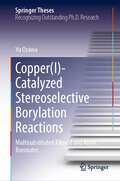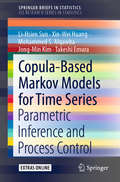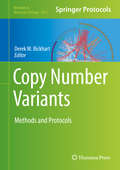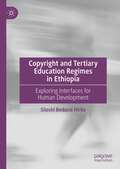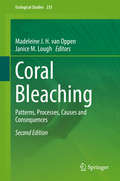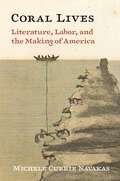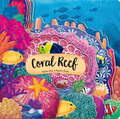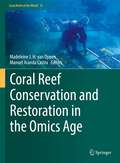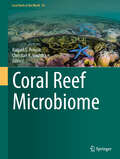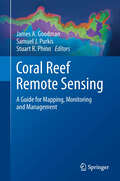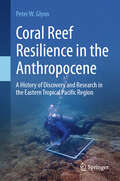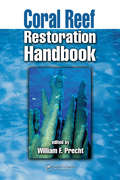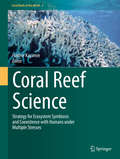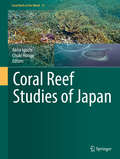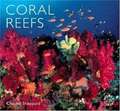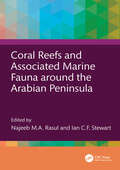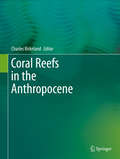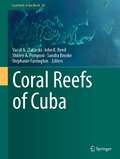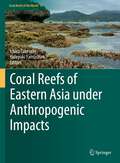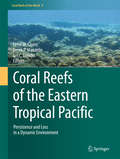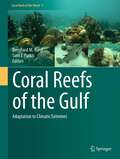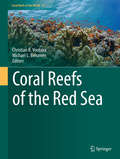- Table View
- List View
Copper: Multisubstituted Alkenyl and Allylic Boronates (Springer Theses)
by Yu OzawaThis book focuses on the development of novel functionalized organoboron compounds and those synthetic methods. High degrees of chemo-, regio-, and stereoselectivities of the borylation reactions are attained through catalyst design and optimization. Furthermore, the selectivity-determining mechanisms are analyzed with state-of-the-art DFT and other computational methods. In this book, the author synthesizes some multi-substituted alkenyl and allylic boronates via borylation reactions using a copper(I)/diboron catalyst system. Those compounds contain novel densely substituted and distorted structures, which have not been accessed by other methods. The high stereoselectivities are achieved by the optimization of the catalyst, especially the ligand. Some new ligands are also developed in this book. Furthermore, the derivatization of the borylation products is demonstrated to access the sterically demanding complex molecules. Also, the author performs computational analysis to reveal how the catalyst controls the selectivities. The deep insight into the reaction mechanism provides guides for rational catalyst design for not only copper(I) catalysis but also other transition metal catalysis. Thus, the content should be of interest to academic and industrial scientists in a wide range of areas.
Copula-Based Markov Models for Time Series: Parametric Inference and Process Control (SpringerBriefs in Statistics)
by Takeshi Emura Li-Hsien Sun Xin-Wei Huang Mohammed S. Alqawba Jong-Min KimThis book provides statistical methodologies for time series data, focusing on copula-based Markov chain models for serially correlated time series. It also includes data examples from economics, engineering, finance, sport and other disciplines to illustrate the methods presented. An accessible textbook for students in the fields of economics, management, mathematics, statistics, and related fields wanting to gain insights into the statistical analysis of time series data using copulas, the book also features stand-alone chapters to appeal to researchers. As the subtitle suggests, the book highlights parametric models based on normal distribution, t-distribution, normal mixture distribution, Poisson distribution, and others. Presenting likelihood-based methods as the main statistical tools for fitting the models, the book details the development of computing techniques to find the maximum likelihood estimator. It also addresses statistical process control, as well as Bayesian and regression methods. Lastly, to help readers analyze their data, it provides computer codes (R codes) for most of the statistical methods.
Copy Number Variants: Methods and Protocols (Methods in Molecular Biology #1833)
by Derek M. BickhartThis volume offers detailed step-by-step instructions to allow beginners and experts alike to run appropriate copy number variants (CNV) detection software on a dataset of choice and discern between false positive noise and true positive CNV signals. Chapters guide readers through single nucleotide polymorphism (SNP) chips, optical mapping assembly techniques, and current open-source programs specializing in CNV detection. Written in the highly successful Methods in Molecular Biology series format, chapters include introductions to their respective topics, lists of the necessary materials and reagents, readily reproducible laboratory protocols, and tips on troubleshooting and avoiding known pitfalls. Authoritative and cutting-edge, Copy Number Variants: Methods and Protocols aims to provide guidance to Bioinformaticians and Molecular Biologists who are interested in identifying copy number variants (CNV) with a wide variety of experimental media
Copyright and Popular Media
by Trajce CvetkovskiCopyright governance is in a state of flux because the boundaries between legal and illegal consumption have blurred. Trajce Cvetkovski interrogates the disorganizational effects of piracy and emerging technologies on the political economy of copyright in popular music, film and gaming industries.
Copyright and Tertiary Education Regimes in Ethiopia: Exploring Interfaces for Human Development
by Sileshi Bedasie HirkoThis book explores the interlinkages between copyright and tertiary education regimes, and their complementary roles for sustainable human development. Emphasizing issues that are not addressed in-depth in the existing works, this book employs a new theoretical perspective in order to inform the exploration of the interlinkages through the lens of human development. To this effect, the book adopts the capabilities approach (CA) as an inclusive development framework that is suitable for examining the interfaces among copyright, tertiary education, and human development in Ethiopia.
Coral Bleaching: Patterns, Processes, Causes and Consequences (Ecological Studies #233)
by Madeleine J. van Oppen Janice M. LoughOne of the most serious consequences of global climate change for coral reefs is the increased frequency and severity of mass coral bleaching events and, since the first edition of this volume was published in 2009, there have been additional mass coral bleaching events. This book provides comprehensive information on the causes and consequences of coral bleaching for coral reef ecosystems, from the genes and microbes involved in the bleaching response, to individual coral colonies and whole reef systems. It presents detailed analyses of how coral bleaching can be detected and quantified and reviews future scenarios based on modeling efforts and the potential mechanisms of acclimatisation and adaptation. It also briefly discusses emerging research areas that focus on the development of innovative interventions aiming to increase coral climate resilience and restore reefs.
Coral Lives: Literature, Labor, and the Making of America
by Michele Currie NavakasA literary and cultural history of coral—as an essential element of the marine ecosystem, a personal ornament, a global commodity, and a powerful political metaphorToday, coral and the human-caused threats to coral reef ecosystems symbolize our ongoing planetary crisis. In the nineteenth century, coral represented something else; as a recurring motif in American literature and culture, it shaped popular ideas about human society and politics. In Coral Lives, Michele Currie Navakas tells the story of coral as an essential element of the marine ecosystem, a cherished personal ornament, a global commodity, and a powerful political metaphor. Drawing on a wide range of sources, including works by such writers as Sarah Josepha Hale, Harriet Beecher Stowe, Frances Ellen Watkins Harper, and George Washington Cable, Navakas shows how coral once helped Americans to recognize both the potential and the limits of interdependence—to imagine that their society could grow, like a coral reef, by sustaining rather than displacing others.Navakas shows how coral became deeply entwined with the histories of slavery, wage labor, and women’s reproductive and domestic work. If coral seemed to some nineteenth-century American writers to be a metaphor for a truly just collective society, it also showed them, by analogy, that society can seem most robust precisely when it is in fact most unfree for the laborers sustaining it. Navakas’s trailblazing cultural history reveals that coral has long been conceptually indispensable to humans, and its loss is more than biological. Without it, we lose some of our most complex political imaginings, recognitions, reckonings, and longings.
Coral Reef
by Martin Šodjr Radka PíroDive into the ocean, explore the colorful coral reef, and learn about the sea animals who call it home in this amazing picture book.The ocean is a magical place with so much to see. So, grab your snorkel and swim around a beautiful coral reef where you&’ll discover all the amazing sea creatures who live there! From hermit crabs, fish, and eels to sea horses, octopuses, dolphins, and so much more, this picture book lets you peek inside while learning tons of fun facts about these stunning animals and their lives inside a coral reef.&“Engaging, informative, and best of all—fun!&” —Cheryl Butler, host of The Mighty Mommy podcastThis is a fixed-format ebook, which preserves the design and layout of the original print book
Coral Reef Conservation and Restoration in the Omics Age (Coral Reefs of the World #15)
by Madeleine J. H. van Oppen Manuel Aranda LastraThe rapid demise of coral reefs worldwide has spurred efforts to develop innovative conservation and restoration methods. Many of these rely on omics approaches to produce genetic, genomic, transcriptomic, epigenomic or metabolomic data to inform conservation and restoration interventions. This book provides the state of play of this field. It discusses topics ranging from how genomic and environmental DNA (eDNA) data can be used to inform marine protected area design and cryopreservation strategies, the use of knowledge on adaptive genetic and epigenetic variation to maximise environmental stress tolerance of coral stock, harnessing transcriptome data to develop early warning markers, the use of microbial symbiont omics data in guiding restoration strategies, to applications of metabolomics and genetic engineering. How best to translate omics data to resource managers is also discussed.
Coral Reef Microbiome (Coral Reefs of the World #20)
by Christian R. Voolstra Raquel S. PeixotoMicroorganisms, the catalysts of all biogeochemical cycles on Earth, are the origin and essence of life—an invisible yet powerful force sustaining all living organisms. The health of both individual organisms and ecosystems critically depends on functional microbiomes that drive essential processes such as nutrient cycling, pathogen control, detoxification, and resilience. However, like their macroorganism counterparts, these beneficial microbes are vulnerable to environmental changes, and their decline often accelerates ecosystem degradation. Anthropogenic impacts have profoundly altered and often degraded most ecosystems and their microbiomes, with coral reefs being no exception. Stony corals, the foundation of these vibrant ecosystems, are among the most threatened marine organisms. Shifts in coral microbiomes toward dysbiotic (harmful) assemblages are increasingly recognized as both a cause and consequence of coral mortality. In response, active intervention strategies are being developed to restore and rehabilitate degraded microbiomes, aiming to restore and re-establish the beneficial microbial communities that sustain the health of both their host organisms and ecosystems. The success of these approaches depends on our understanding of the distribution, ecological roles, and interactions between corals and their associated microbiomes, as well as how environmental factors influence them and their potential to either amplify or mitigate anthropogenic impacts. This book delves into these topics, examining how they shape coral holobiont assemblages and offer pathways for active intervention. In addition, this book provides a practical, tailored, and adaptable roadmap for stakeholders to integrate the latest insights into a broader One Health framework and ecosystem perspective.
Coral Reef Remote Sensing: A Guide for Mapping, Monitoring and Management
by James A. Goodman Samuel J. Purkis Stuart R. PhinnRemote sensing stands as the defining technology in our ability to monitor coral reefs, as well as their biophysical properties and associated processes, at regional to global scales. With overwhelming evidence that much of Earth's reefs are in decline, our need for large-scale, repeatable assessments of reefs has never been so great. Fortunately, the last two decades have seen a rapid expansion in the ability for remote sensing to map and monitor the coral reef ecosystem, its overlying water column, and surrounding environment. Remote sensing is now a fundamental tool for the mapping, monitoring and management of coral reef ecosystems. Remote sensing offers repeatable, quantitative assessments of habitat and environmental characteristics over spatially extensive areas. As the multi-disciplinary field of coral reef remote sensing continues to mature, results demonstrate that the techniques and capabilities continue to improve. New developments allow reef assessments and mapping to be performed with higher accuracy, across greater spatial areas, and with greater temporal frequency. The increased level of information that remote sensing now makes available also allows more complex scientific questions to be addressed. As defined for this book, remote sensing includes the vast array of geospatial data collected from land, water, ship, airborne and satellite platforms. The book is organized by technology, including: visible and infrared sensing using photographic, multispectral and hyperspectral instruments; active sensing using light detection and ranging (LiDAR); acoustic sensing using ship, autonomous underwater vehicle (AUV) and in-water platforms; and thermal and radar instruments. Emphasis and Audience This book serves multiple roles. It offers an overview of the current state-of-the-art technologies for reef mapping, provides detailed technical information for coral reef remote sensing specialists, imparts insight on the scientific questions that can be tackled using this technology, and also includes a foundation for those new to reef remote sensing. The individual sections of the book include introductory overviews of four main types of remotely sensed data used to study coral reefs, followed by specific examples demonstrating practical applications of the different technologies being discussed. Guidelines for selecting the most appropriate sensor for particular applications are provided, including an overview of how to utilize remote sensing data as an effective tool in science and management. The text is richly illustrated with examples of each sensing technology applied to a range of scientific, monitoring and management questions in reefs around the world. As such, the book is broadly accessible to a general audience, as well as students, managers, remote sensing specialists and anyone else working with coral reef ecosystems.
Coral Reef Resilience in the Anthropocene: A History of Discovery and Research in the Eastern Tropical Pacific Region
by Peter W. GlynnThis book chronicles six decades of exploration and ecological studies of Western American coral reefs, a vibrant and diverse ecosystem in a marginal tropical Pacific region that has long been overlooked. It begins with the discovery of pristine coral reefs in Panama in the 1960s, follows the impact of stressful El Niño warming events that caused widespread coral bleaching and mortality in the 1980s-1990s, documents coral recovery in the late 1990s and early 2000s, and addresses the recent resurgence (2023-24) of extreme El Niño events leading to renewed coral mortality and setbacks in reef recovery. The book delves into the challenges posed by the physical environment, including recurring ENSO activity and increasing ocean acidification, and examines key ecological research topics such as coral reproduction, predation, bioerosion, symbioses, and biodiversity. It also highlights recent molecular genetic advancement in understanding coral endosymbionts, species identification, and phylogenetic relationships. Along the way, personal anecdotes from the eastern Pacific coral research team – ranging from exhilarating to amusing, frightening, and occasionally embarrassing – are shared throughout this scientific journey. This narrative offers a glimpse into the community composition of species and their interactions before severe bleaching and widespread coral mortality, information that is necessary to help guide restoration work. Sketches of coral reef animal associates by Peter W. Glynn and the late Charles Messing add an artistic dimension, highlighting the ecological roles of various species within the reef ecosystem. Many students have made significant contributions to the understanding and conservation of eastern Pacific coral reefs, with several going on to pursue careers in academia, research, and restoration, emerging as the next generation of reef scientists. The book concludes with a cautiously optimistic hope that humanity will shift away from reliance on fossil fuels, and that Generation Z (and their future students) will discover ways to restore coral reefs for future generations.
Coral Reef Restoration Handbook
by William F. Precht" this book is the first to describe, in detail, the art and science of coral reef restoration. It is to be hoped that the information that can be gleaned within the pages of this book will set a path towards continued preservation of this valuable underwater treasure to be used, appreciated, and experienced for future generations."-- Senator
Coral Reef Science: Strategy for Ecosystem Symbiosis and Coexistence with Humans under Multiple Stresses (Coral Reefs of the World #5)
by Hajime KayanneThis book aims to illuminate coral reefs which comprise a symbiotic system coexisting among ecosystems, landforms, and humans at various levels and to provide a scientific basis for its reconstruction. The authors conducted an interdisciplinary project called "Coral Reef Science" from 2008 to 2012 and obtained novel results and clues to unite different disciplines for a coral reef as a key ecosystem.
Coral Reef Studies of Japan (Coral Reefs of the World #13)
by Akira Iguchi Chuki HongoThis book comprehensively introduces recent important studies on coral reefs from various research fields including biology, ecology, chemistry, the earth sciences, and conservation studies. Coral reef is one of the important ecosystems characterized by high biodiversity and the beauty. Coral reefs around Japan are located at the northern limit, composed by mainly fringing reefs along archipelago, and easily impacted by human activities. Thus, coral reef studies around Japan have provided important knowledge on basic sciences and conservation studies regarding coral reef ecosystem. This book would contribute to systematic understanding of vulnerable coral reef ecosystems due to human activities in the Indo-Pacific and Caribbean regions. The conservation efforts provide good reference to graduate and undergraduate students, and researchers in marine sciences, as well as those who are involved in coral reef studies.
Coral Reefs (WorldLife Library)
by Charles SheppardCoral reefs are one of the wonders of the natural world. Protecting thousands of miles of shoreline from erosion, these intricate structures support biodiversity essential to the balance of the world's ecosystems. They are one of nature's most significant and ancient infrastructures. Global warming and our overuse of the reefs is causing untold damage to these beautiful yet fragile formations. In this lavishly illustrated book, Dr. Charles Sheppard explores the underwater world of coral reefs. Using popular examples from around the world, he explains how these vast constructs function and what must be done to save them.
Coral Reefs and Associated Marine Fauna around the Arabian Peninsula
by Najeeb M.A. Rasul Ian C.F. StewartCoral Reefs and Associated Marine Fauna around the Arabian Peninsula is a unique text that contains studies on a diverse range of topics related to the biology of the Red Sea and Arabian (Persian) Gulf region.Containing invited and peer-reviewed chapters, this book is a compilation of the works of various experts in their respective fields. The authors delve into the marine fauna around the Arabian Peninsula, including marine reptiles and mammals, coral reefs, fish, invertebrates, algae and phytoplankton. They also explore the changes resulting from anthropogenic and climate effects.This book will be a helpful resource for researchers in Biology and will also be a valuable reference for anyone interested in the biology of these two warm semi-isolated seas with their unique environments.
Coral Reefs in the Anthropocene
by Charles BirkelandThis volume investigates the effects of human activities on coral reefs, which provide important life-supporting systems to surrounding natural and human communities. It examines the self-reinforcing ecological, economic and technological mechanisms that degrade coral reef ecosystems around the world. Topics include reefs and limestones in Earth history; the interactions between corals and their symbiotic algae; diseases of coral reef organisms; the complex triangle between reef fishes, seaweeds and corals; coral disturbance and recovery in a changing world. In addition, the authors take key recent advances in DNA studies into account which provides new insights into the population biology, patterns of species distributions, recent evolution and vulnerabilities to environmental stresses. These DNA analyses also provide new understandings of the limitations of coral responses and scales of management necessary to sustain coral reefs in their present states. Coral reefs have been essential sources of food, income and resources to humans for millennia. This book details the delicate balance that exists within these ecosystems at all scales, from geologic time to cellular interactions and explores how recent global and local changes influence this relationship. It will serve as an indispensable resource for all those interested in learning how human activities have affected this vital ecosystem around the world.
Coral Reefs of Cuba (Coral Reefs of the World #18)
by Vassil N. Zlatarski John K. Reed Shirley A. Pomponi Sandra Brooke Stephanie FarringtonThis comprehensive volume gathers foremost experts on the coral reefs of Cuba who represent a spectrum of disciplines, including biology, conservation ecology, economics and geology. The volume is organized along general themes including the Cuban Reef biota, reefs occurring in the Mesophotic and Eutrophic zones, ecology, conservation, management and the economic importance of the coral reefs of Cuba. The combination of case studies, new and previously published research, historical overview and examples of the ways in which research has contributed to the management and conservation of Cuban coastal resources provides a unique reference for graduate students and professionals holding a wide range of interests and expertise related to coral reef systems.
Coral Reefs of Eastern Asia under Anthropogenic Impacts (Coral Reefs of the World #17)
by Ichiro Takeuchi Hideyuki YamashiroCoral reefs, which are one of the most productive and biodiverse ecosystems on Earth, serve various important roles, such as providing shelter and spawning grounds to a wide range of marine animals. However, the global decline of hard corals in tropical and subtropical regions is a growing concern. A recent review of the Intergovernmental Panel on Climate Change (IPCC) indicated that only 10%–30% of coral reefs would survive with an increase of 1.5 °C in global warming temperature. Of coral reefs around the world, the coral reefs in eastern Asia face one of the most industrially developed and high population areas in the world. Thus, coral reefs of eastern Asia have been affected by various anthropogenic factors, such as eutrophication, coastal development, anthropogenic pollutants, ocean acidification, disease, and overfishing. Therefore, urgent research is required to determine the levels at which different factors will affect coral health. Besides, we propose a perspective on coral reef (especially those in eastern Asia) conservation under climate change and various anthropogenic activities.
Coral Reefs of Singapore's Urbanised Sea (Coral Reefs of the World #23)
by Loke Ming Chou Danwei HuangThis book highlights how Singapore&’s coral reef system is responding to changing environmental conditions caused by urbanization and climate change. It provides a fundamental understanding of how reefs respond to decades of chronic urbanization impacts and episodic marine heatwave events, with studies revealing responses at molecular, cellular, organismal, and community levels. Knowing what drives the persistence of coral-dominated reefs through urbanization and global warming impacts will contribute to the formulation of effective conservation strategies. The chapters cover topics such as the impacts of sedimentation on coral communities, the energetic needs of corals in extreme environments, and the diversity of Symbiodiniaceae dinoflagellates. Readers will discover insights into the resilience of coral reefs, the role of microbiomes, and the thriving coral reef fishes in Singapore&’s urban reef system. This literature invites readers to think through critical questions about conservation status and biological connectivity in urbanized seascapes. Contributions from distinguished scholars and practitioners provide expert insights into theoretical frameworks and practical case studies, addressing topics such as the impacts of climate change, the persistence of coral-dominated reefs in the face of substantial losses and bleaching events, and strategies for management and reef restoration initiatives. Researchers, ecologists, and reef managers will find this book invaluable. It offers a comprehensive analysis of Singapore&’s coral reefs, making it essential for anyone interested in marine conservation, urban ecology, and sustainable development. This volume is a crucial resource for understanding and managing coral reef resilience in the face of urbanization and climate change. Scholars, students, and practitioners in marine biology, environmental science, and urban planning will benefit from the insights and strategies presented. As governments seek to fulfil obligations to COP and UN Sustainable Development Goal 14, this book provides the scientific foundation needed to guide effective conservation measures in tropical coastal cities.
Coral Reefs of the Eastern Tropical Pacific: Persistence and Loss in a Dynamic Environment (Coral Reefs of the World #8)
by Peter W. Glynn Derek P. Manzello Ian C. EnochsThis book documents and examines the state of health of coral reefs in the eastern tropical Pacific region. It touches on the occurrence of coral reefs in the waters of surrounding countries, and it explores their biogeography, biodiversity and condition relative to the El Niño southern oscillation and human impacts. Additionally contained within is a field that presents information on many of the species presented in the preceding chapters.
Coral Reefs of the Gulf: Adaptation to Climatic Extremes (Coral Reefs of the World #3)
by Sam J. Purkis Bernhard M. RieglCoral Reefs of the Gulf: Adaptation to Climatic Extremes is a complete review and reference for scientists, engineers and students concerned with the geology, biology or engineering aspects of coral reefs in the Middle East. It provides for the first time a complete review of both the geology and biology of all extant coral areas in the Gulf, the water body between Iran and the Arabian Peninsula. In summer, this area is the hottest sea with abundant coral growth on earth and already today exhibits a temperature that is predicted to occur across the topical ocean in 2100. Thus, by studying the Gulf today, much can be learned about tomorrow's world and the capability of coral reefs to adapt to climatic extremes. This volume provides the most authoritative and up-to-date review of the coral reefs in the Gulf. It can be used as a volume of general reference or as a textbook treating recent coral reefs. Written by local and international experts, the text is richly illustrated and will remain a standard reference for the region for decades to come. Contributions stretch from climatology through geology, biology, ecological modelling and fisheries science to practical conservation aspects. The book is useful for the technical expert and casual reader alike.
Coral Reefs of the Red Sea (Coral Reefs of the World #11)
by Christian R. Voolstra Michael L. BerumenThis volume is a complete review and reference work for scientists, engineers, and students concerned with coral reefs in the Red Sea. It provides an up-to-date review on the geology, ecology, and physiology of coral reef ecosystems in the Red Sea, including data from most recent molecular studies. The Red Sea harbours a set of unique ecological characteristics, such as high temperature, high alkalinity, and high salinity, in a quasi-isolated environment. This makes it a perfect laboratory to study and understand adaptation in regard to the impact of climate change on marine ecosystems. This book can be used as a general reference, guide, or textbook.
